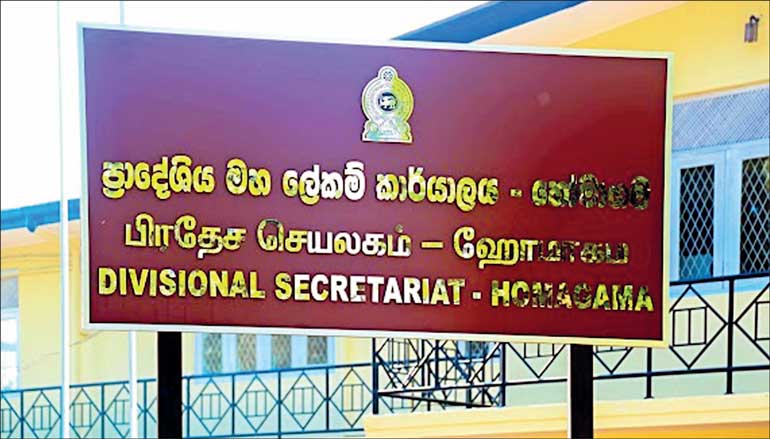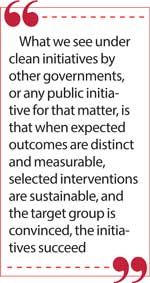Saturday Apr 19, 2025
Saturday Apr 19, 2025
Wednesday, 22 January 2025 00:22 - - {{hitsCtrl.values.hits}}

It is not possible to expect all local government institutions to join the Clean Sri Lanka project whole-heartedly. However, they can be rallied through various fiscal policy instruments
 On 1 January 2025, President Anura Kumara Dissanayake announced the launching of a Clean Sri Lanka initiative with the aim of “uplifting society to greater heights through a social, environmental, and ethical revival”. He also appointed a task force for the purpose.
On 1 January 2025, President Anura Kumara Dissanayake announced the launching of a Clean Sri Lanka initiative with the aim of “uplifting society to greater heights through a social, environmental, and ethical revival”. He also appointed a task force for the purpose.
Clean Sri Lanka is indeed an important initiative for the Government as well as the country. As a country emerging from a severe economic crisis the NPP Government or any government for that matter has only bitter medicine to offer the people of Sri Lanka on the economic front. Despite pre-election promises by NPP, voters could not have been unaware of that fact when they voted NPP into power. Therefore, one might expect some flexibility on the economic front from the voters if the Government keeps the economy on track without relapsing into dire straits of shortages and queues. But the promise of a clean government and a clean society are more serious. If the NPP Government does not at least show that it is moving towards a clean government and a clean society, economic hardships will be felt more acutely, and there will be consequences not only for the Government but the country. From that perspective, it is correct that the Government creates the hope of not only environmental cleanliness but also a “social and moral revival” through the Clean Sri Lanka initiative. The challenge is how to achieve these multiple and complex goals.
According to the initial comments made to the media by some members of the task force in the past few days, it appears that they have not yet completed the planning. But it is a positive sign that the task force is open to sharing information. They should be given some leeway to get started and supported to the extent possible. In that spirit, the purpose of this article is to look at the project from a policy analysis perspective and offer some ideas.
My analysis in a nutshell is that the Clean Sri Lanka brand should be focused on specific and measurable environmental goals as in Swachh Bharat of India or Clean Singapore, while providing guidance and creating the conditions for the broader social and moral goals. Otherwise, the initiative would find itself scraping the surface on multiple fronts with no gains to show on any one of them, as in the analogy made by a poor old woman on the war strategy of the legendary King Dutugemunu after seeing him struggling to tackle the hot kiri bath dish she offered.
The scope is too broad
 The Clean Sri Lanka project is expected to achieve both physical cleanliness of the environment and moral cleanliness of society.
The Clean Sri Lanka project is expected to achieve both physical cleanliness of the environment and moral cleanliness of society.
The environmental domain consists of the natural environment of forests, canals, rivers, lakes, ponds, oceans and the atmosphere and the organisms that inhabit them, and the built environment consists of cities, villages, public or private spaces, public utilities, roads, vehicles, and even domesticated animals and pets and more.
The societal domain includes individuals, families, communities, and government, non-government and private institutions.
With such a wide range of domains and subdomains, the possible interventions are innumerable. The project cannot and should not take responsibility for the cleanliness of all these domains and subdomains. For example, the policing of public transport vehicles implemented in conjunction with the launch of the Clean Sri Lanka project does not need to be done under the Clean Sri Lanka brand.
Lessons from Clean Singapore and Swachh Bharat
The Clean Singapore concept has evolved through several stages, with the prohibition of spitting, for example, in 1992. Each of these stages had a specific and simple goal. It seems that Singapore has now achieved the ability to focus on four cleanliness issues together – i.e. dengue control, cleanliness of public toilets, waste minimisation and attention to recycling. The cleanliness of public toilets has been in focus before. Presumably now they are looking at a higher level of cleanliness.
The first phase of India’s Swachh Bharat Mission which began in 2014 aimed to achieve an open defecation-free (ODF) India. Official figures show that by 2021 nearly 100 million toilets have been built, increasing the percentage of households with toilets from 39% to almost 100%. There is evidence that this has improved the health of children which is an indirect outcome of Swachh Bharat. Official figures for ODF, the expected direct outcome, claim that most states have achieved 100% ODF outcome but the numbers are disputed. The methods of measurement should improve over time and the good news is that the availability of a clear outcome gives an opportunity to track success. The second phase of Swachh Bharat Swachh Bharat 2.0 aimed at urban waste management began in 2021.
The expected or stated goal of the Clean Singapore and Swachh Bharat projects is clearly environmental cleanliness. The stated goal does not involve any larger societal goals. However, emerging studies are showing that there has been a change in attitudes within families and society towards women’s hygiene and their dignity within the family. The same is true for Clean Singapore. Larger social goals can be offshoots of specific environmental goals.
What we see under clean initiatives by other governments, or any public initiative for that matter, is that when expected outcomes are distinct and measurable, selected interventions are sustainable, and the target group is convinced, the initiatives succeed. Larger social objectives which are more difficult to achieve can be pursued as aspirational outcomes under the safe umbrella of a few specific and measurable outcomes.
Therefore, the Clean Sri Lanka project needs to be considered in two parts (1) measurable environmental goals, and (2) Aspirational societal goals or additional environmental goals.
Firstly, some specific environmental goals
 As explained by Sandhya Salgado, a member of the Clean Sri Lanka Task Force, at a Sirasa “Pathiakada” program, the taskforce is developing a plan that includes some low hanging fruits as well activities with long-term key performance goals. That is a good sign. The cleanliness of the public toilet system and the behaviour on public roads were two of the issues mentioned there. Waste minimisation is also an environmental goal where the country has invested much for little gain. Selecting a few such goals, implementing them immediately, and continuing to monitor and report on their success will do much to build public confidence in the Clean Sri Lanka initiative.
As explained by Sandhya Salgado, a member of the Clean Sri Lanka Task Force, at a Sirasa “Pathiakada” program, the taskforce is developing a plan that includes some low hanging fruits as well activities with long-term key performance goals. That is a good sign. The cleanliness of the public toilet system and the behaviour on public roads were two of the issues mentioned there. Waste minimisation is also an environmental goal where the country has invested much for little gain. Selecting a few such goals, implementing them immediately, and continuing to monitor and report on their success will do much to build public confidence in the Clean Sri Lanka initiative.
That does not mean that other parties cannot implement ‘clean’ projects or that we should not talk about broader attitudinal change. Projects using the Clean Sri Lanka brand should be done responsibly with limitations, with larger societal changes recognised as an outcome of the specific goals or additional aspirational goals.
Secondly, aspirational social goals
The implementation of a few specific environmental goals should be immediately handed over to a project office or secretariat operating under the performance committee. But it is difficult for such a centralised office to do more than a media campaign to widely spread the concept of Clean Sri Lanka in the society including the public institutions.
Another member of the task force, Gamini Batuwitage, in an interview on the “dishawa” program on Rupavahini gave a clue as to how the taskforce may aim for larger social goals. He talked about using a 10-point value system as the basis of the project and giving responsibility at the institutional level to all state institutions to abide by it. The 10 points included unity, accountability and other values. He suggested all state institutions should display these values prominently and heads of institutions given the responsibility to run their institutions accordingly. I would like to add two improvements to the proposal.
First, there should be some correspondence between these Clean Sri Lanka values and the values that are currently embedded in national goals of education. Second, I think it is more practical to present these values as citizen charters that are encapsulated in the performance targets related to each institution.
Batuwitage also talked about using Community Safety Committees (Praja Arakshana Kamitu) or similar ground level committees to take Clean Sri Lanka to the grassroots. I have some reservations on the proposal because we already have a well-established local council system whose goals coincide with Clean Sri Lanka goals. Also, we have had bad experiences, internationally and locally, in mobilising forces parallel to existing statutory bodies such as local councils and affiliated bodies.
Local councils as drivers of ground level social goals
 The central government has a tendency to implement development projects through the divisional secretariats which serve as the administrative arm of the central government, by passing local councils. A divisional secretariat is the terminal institution in the central government’s administrative mechanism with a Grama Niladhari being only an individual placed at the village level. The Grama Niladharis do not have implementation capacity. It is local councils which have the statutory responsibility and the fiscal and physical capacity for local development, because each of the relevant Acts give the Municipal Councils, Urban Councils and Pradeshiya Sabhas the responsibility for public health, public utilities, roads and the comfort, convenience and welfare of the people at the village or city level and taxation for the purpose.
The central government has a tendency to implement development projects through the divisional secretariats which serve as the administrative arm of the central government, by passing local councils. A divisional secretariat is the terminal institution in the central government’s administrative mechanism with a Grama Niladhari being only an individual placed at the village level. The Grama Niladharis do not have implementation capacity. It is local councils which have the statutory responsibility and the fiscal and physical capacity for local development, because each of the relevant Acts give the Municipal Councils, Urban Councils and Pradeshiya Sabhas the responsibility for public health, public utilities, roads and the comfort, convenience and welfare of the people at the village or city level and taxation for the purpose.
Ward committees in local councils as built in vehicles
More than 5,000 members were elected in 2018 from 4,909 wards for 341 local councils across the country. In addition, more than 3,000 members are elected from Party lists to achieve proportional representation in the result. The need to divide each local council into wards to form ward committees was recommended as far back as 1991 in a report by a Presidential Commission of Inquiry into local government. With the demarcation of local councils into wards as per the mixed-member-proportional electoral method introduced in 2017, we have the conditions necessary to form ward committees to oversee development in each ward. In fact, the Ministry of Local Government and Provincial Councils has already drafted legislation for changes in the local government structure, including the establishment of such Ward Committees.
As envisioned, the chairmanship of such ward committees would be held by the individual (or individuals in the case of multi-member wards) elected first past the post in a ward, but the membership of the committee will be apolitical and selected through a statutory process from among active civil society leaders and residents in a ward. The ward committees would determine development priorities for each ward and the local council is legally bound to take those into consideration as they budget and plan for the development of the council area. If these development priorities result in Clean Sri Lanka interventions by each council, such interventions would be truly bottom up and participatory.
Proceed with caution on Jana Sabhas and other extraneous bodies
Over time we have seen some form of additional participatory mechanisms in government come and go under different names. People’s committees, Gramodaya Mandalas, Gami Diriya, Jana Sabhas as instruments of the Divi Neguma program or Jana Sabhas as independent bodies are some of the examples. None of them have sustained. As I see it, the fundamental reason for the failure of all these efforts is that they are either set up by the central government as instruments of control outside the three-tier representative democratic structure of the Parliament, Provincial Councils and Local Councils, or they deteriorate into such instruments. For example, the people’s committees set up by the coalition government elected in 1970 were later nicknamed and derided by people as “kelam kamitu” or “snitch committees”.
Gamini Batuwitage himself describes in a 2014 paper titled “Limits to empowerment: case of control and citizen engagement in community driven development in Sri Lanka” how the community-based concept of Gami Diriya was politicised and weakened by turning them into Jana Sabhas associated with the Divi Neguma initiative of the central government (Batuwitage, 2014.).
An international example is the attempt by the government in Venezuela in 2015 to override the result of a general election by mobilising the communes or a version of Jana Sabhas established in Venezuela as per their Constitution as a fourth force parallel to the representative government system. We should be aware of the dangers of a fourth force outside of the three-tier representative government system that we have now.
Local councils and/or ward committees need motivation
It is not possible to expect all local government institutions to join the Clean Sri Lanka project whole-heartedly. However, they can be rallied through various fiscal policy instruments. For example, a portion of the allocations provided to local government institutions can be set aside as a Clean Sri Lanka Fund. This fund can be used to invite each local government to submit Clean Sri Lanka project proposals with specific project goals. The fund can provide seed money for their plans and provide additional funding as their projects progress. The grants should be substantial enough for local councils to take notice and act. Similar efforts have been made in the past regarding waste management, and much can be learned from their successes or failures.
Discover Kapruka, the leading online shopping platform in Sri Lanka, where you can conveniently send Gifts and Flowers to your loved ones for any event including Valentine ’s Day. Explore a wide range of popular Shopping Categories on Kapruka, including Toys, Groceries, Electronics, Birthday Cakes, Fruits, Chocolates, Flower Bouquets, Clothing, Watches, Lingerie, Gift Sets and Jewellery. Also if you’re interested in selling with Kapruka, Partner Central by Kapruka is the best solution to start with. Moreover, through Kapruka Global Shop, you can also enjoy the convenience of purchasing products from renowned platforms like Amazon and eBay and have them delivered to Sri Lanka.
Discover Kapruka, the leading online shopping platform in Sri Lanka, where you can conveniently send Gifts and Flowers to your loved ones for any event including Valentine ’s Day. Explore a wide range of popular Shopping Categories on Kapruka, including Toys, Groceries, Electronics, Birthday Cakes, Fruits, Chocolates, Flower Bouquets, Clothing, Watches, Lingerie, Gift Sets and Jewellery. Also if you’re interested in selling with Kapruka, Partner Central by Kapruka is the best solution to start with. Moreover, through Kapruka Global Shop, you can also enjoy the convenience of purchasing products from renowned platforms like Amazon and eBay and have them delivered to Sri Lanka.